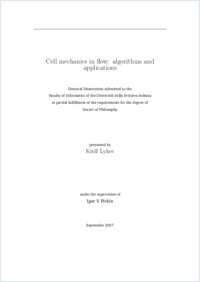Cell mechanics in flow : algorithms and applications
- Lykov, Kirill
- Pivkin, Igor V. (Degree supervisor)
-
05.09.2017
124 p
Thèse de doctorat: Università della Svizzera italiana, 2017
Dissipative particle dynamics
Particle-based methods
Red blood cell modeling
Eukaryotic cell modeling
Blood flow simulations
Microfluidic devices simulations
Boundary conditions
High-performance computations
GPGPU
English
The computer simulations are pervasively used to improve the knowledge about biophysical phenomena and to quantify effects which are difficult to study experimentally. Generally, the numerical methods and models are desired to be as accurate as possible on the chosen length and time scales, but, at the same time, affordable in terms of computations. Until recently, the cell mechanics and blood flow phenomena on the sub-micron resolution could not be rigorously studied using computer simulations. However, within the last decade, advances in methods and hardware catalyzed the development of models for cells mechanics and blood flow modeling which, previously, were considered to be not feasible. In this context, a model should accurately describe a phenomenon, be computationally affordable, and be flexible to be applied to study different biophysical changes. This thesis focuses on the development of the new methods, models, and high-performance software implementation that expand the class of problems which can be studied numerically using particle-based methods. Microvascular networks have complex geometry, often without any symmetry, and to study them we need to tackle computational domains with several inlets and outlets. However, an absence of appropriate boundary conditions for particle- based methods hampers study of the blood flow in these domains. Another obstacle to model complex blood flow problems is the absence the highperformance software. This problem restricts the applicability of the of particlebased cell flow models to relatively small systems. Although there are several validated red blood cell models, to date, there are no models for suspended eukaryotic cells. The present thesis addresses these issues. We introduce new open boundary conditions for particle-based systems and apply them to study blood flow in a part of a microvascular network. We develop a software demonstrating outstanding performance on the largest supercomputers and used it to study blood flow in microfluidic devices. Finally, we present a new eukaryotic cell model which helps in quantifying the effect of sub-cellular components on the cell mechanics during deformations in microfluidic devices.
- Language
-
- English
- Classification
- Computer science and technology
- License
-
License undefined
- Identifiers
-
- RERO DOC 305203
- URN urn:nbn:ch:rero-006-116602
- ARK ark:/12658/srd1318720
- Persistent URL
- https://n2t.net/ark:/12658/srd1318720
Statistics
Document views: 356
File downloads:
- Texte intégral: 418
